Project Evaluation: A Comparative Analysis of NPV and IRR
VerifiedAdded on 2020/05/04
|11
|2839
|63
Report
AI Summary
This report provides a comprehensive analysis of Net Present Value (NPV) and Internal Rate of Return (IRR) techniques used in project evaluation and capital budgeting. The introduction highlights the importance of selecting the best projects for organizational success, emphasizing the role of financial analysis in decision-making. The report defines NPV and IRR, explaining their formulas and applications. A literature review explores existing research on these methods, citing various authors and their contributions. The study aims to identify and analyze both techniques, evaluate their effectiveness, and recommend the best approach for project selection. The methodology section details the use of primary data through project evaluations and secondary sources, including journals and financial publications, along with the use of MS Excel for calculations. The findings demonstrate the advantages and disadvantages of each technique, highlighting NPV's simplicity and focus on present value, and IRR's emphasis on return rates. The report includes calculations of NPV and IRR for example projects, illustrating how these methods can be applied to real-world scenarios and comparing their outcomes. The report concludes with recommendations and a summary of the findings, emphasizing the importance of selecting the most suitable capital budgeting technique to meet organizational objectives. References are provided to support the research and findings.

Running Head: Management Accounting
1
Project Head: Management Accounting
1
Project Head: Management Accounting
Paraphrase This Document
Need a fresh take? Get an instant paraphrase of this document with our AI Paraphraser
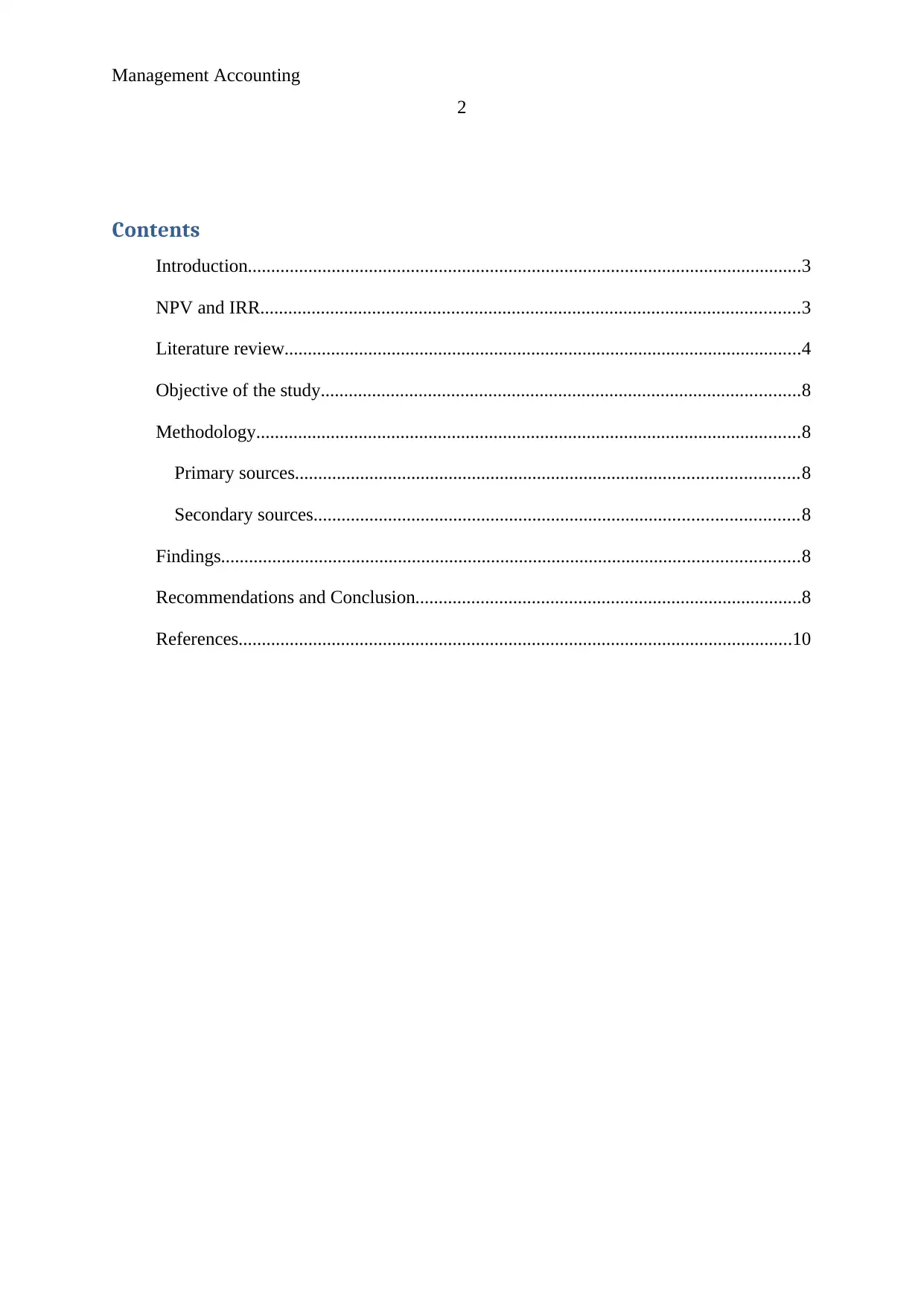
Management Accounting
2
Contents
Introduction.......................................................................................................................3
NPV and IRR....................................................................................................................3
Literature review...............................................................................................................4
Objective of the study.......................................................................................................8
Methodology.....................................................................................................................8
Primary sources............................................................................................................8
Secondary sources........................................................................................................8
Findings............................................................................................................................8
Recommendations and Conclusion...................................................................................8
References.......................................................................................................................10
2
Contents
Introduction.......................................................................................................................3
NPV and IRR....................................................................................................................3
Literature review...............................................................................................................4
Objective of the study.......................................................................................................8
Methodology.....................................................................................................................8
Primary sources............................................................................................................8
Secondary sources........................................................................................................8
Findings............................................................................................................................8
Recommendations and Conclusion...................................................................................8
References.......................................................................................................................10
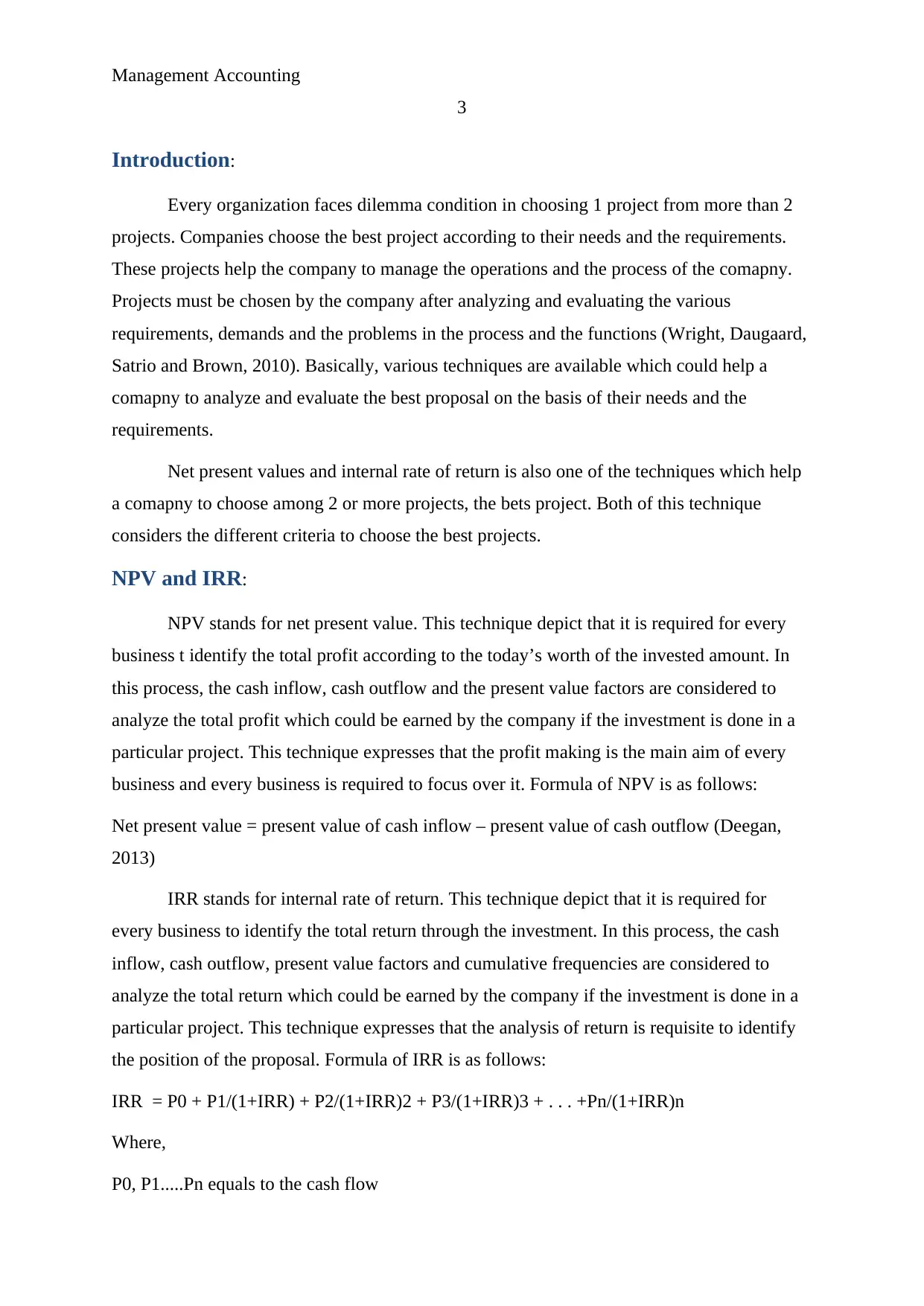
Management Accounting
3
Introduction:
Every organization faces dilemma condition in choosing 1 project from more than 2
projects. Companies choose the best project according to their needs and the requirements.
These projects help the company to manage the operations and the process of the comapny.
Projects must be chosen by the company after analyzing and evaluating the various
requirements, demands and the problems in the process and the functions (Wright, Daugaard,
Satrio and Brown, 2010). Basically, various techniques are available which could help a
comapny to analyze and evaluate the best proposal on the basis of their needs and the
requirements.
Net present values and internal rate of return is also one of the techniques which help
a comapny to choose among 2 or more projects, the bets project. Both of this technique
considers the different criteria to choose the best projects.
NPV and IRR:
NPV stands for net present value. This technique depict that it is required for every
business t identify the total profit according to the today’s worth of the invested amount. In
this process, the cash inflow, cash outflow and the present value factors are considered to
analyze the total profit which could be earned by the company if the investment is done in a
particular project. This technique expresses that the profit making is the main aim of every
business and every business is required to focus over it. Formula of NPV is as follows:
Net present value = present value of cash inflow – present value of cash outflow (Deegan,
2013)
IRR stands for internal rate of return. This technique depict that it is required for
every business to identify the total return through the investment. In this process, the cash
inflow, cash outflow, present value factors and cumulative frequencies are considered to
analyze the total return which could be earned by the company if the investment is done in a
particular project. This technique expresses that the analysis of return is requisite to identify
the position of the proposal. Formula of IRR is as follows:
IRR = P0 + P1/(1+IRR) + P2/(1+IRR)2 + P3/(1+IRR)3 + . . . +Pn/(1+IRR)n
Where,
P0, P1.....Pn equals to the cash flow
3
Introduction:
Every organization faces dilemma condition in choosing 1 project from more than 2
projects. Companies choose the best project according to their needs and the requirements.
These projects help the company to manage the operations and the process of the comapny.
Projects must be chosen by the company after analyzing and evaluating the various
requirements, demands and the problems in the process and the functions (Wright, Daugaard,
Satrio and Brown, 2010). Basically, various techniques are available which could help a
comapny to analyze and evaluate the best proposal on the basis of their needs and the
requirements.
Net present values and internal rate of return is also one of the techniques which help
a comapny to choose among 2 or more projects, the bets project. Both of this technique
considers the different criteria to choose the best projects.
NPV and IRR:
NPV stands for net present value. This technique depict that it is required for every
business t identify the total profit according to the today’s worth of the invested amount. In
this process, the cash inflow, cash outflow and the present value factors are considered to
analyze the total profit which could be earned by the company if the investment is done in a
particular project. This technique expresses that the profit making is the main aim of every
business and every business is required to focus over it. Formula of NPV is as follows:
Net present value = present value of cash inflow – present value of cash outflow (Deegan,
2013)
IRR stands for internal rate of return. This technique depict that it is required for
every business to identify the total return through the investment. In this process, the cash
inflow, cash outflow, present value factors and cumulative frequencies are considered to
analyze the total return which could be earned by the company if the investment is done in a
particular project. This technique expresses that the analysis of return is requisite to identify
the position of the proposal. Formula of IRR is as follows:
IRR = P0 + P1/(1+IRR) + P2/(1+IRR)2 + P3/(1+IRR)3 + . . . +Pn/(1+IRR)n
Where,
P0, P1.....Pn equals to the cash flow
⊘ This is a preview!⊘
Do you want full access?
Subscribe today to unlock all pages.

Trusted by 1+ million students worldwide
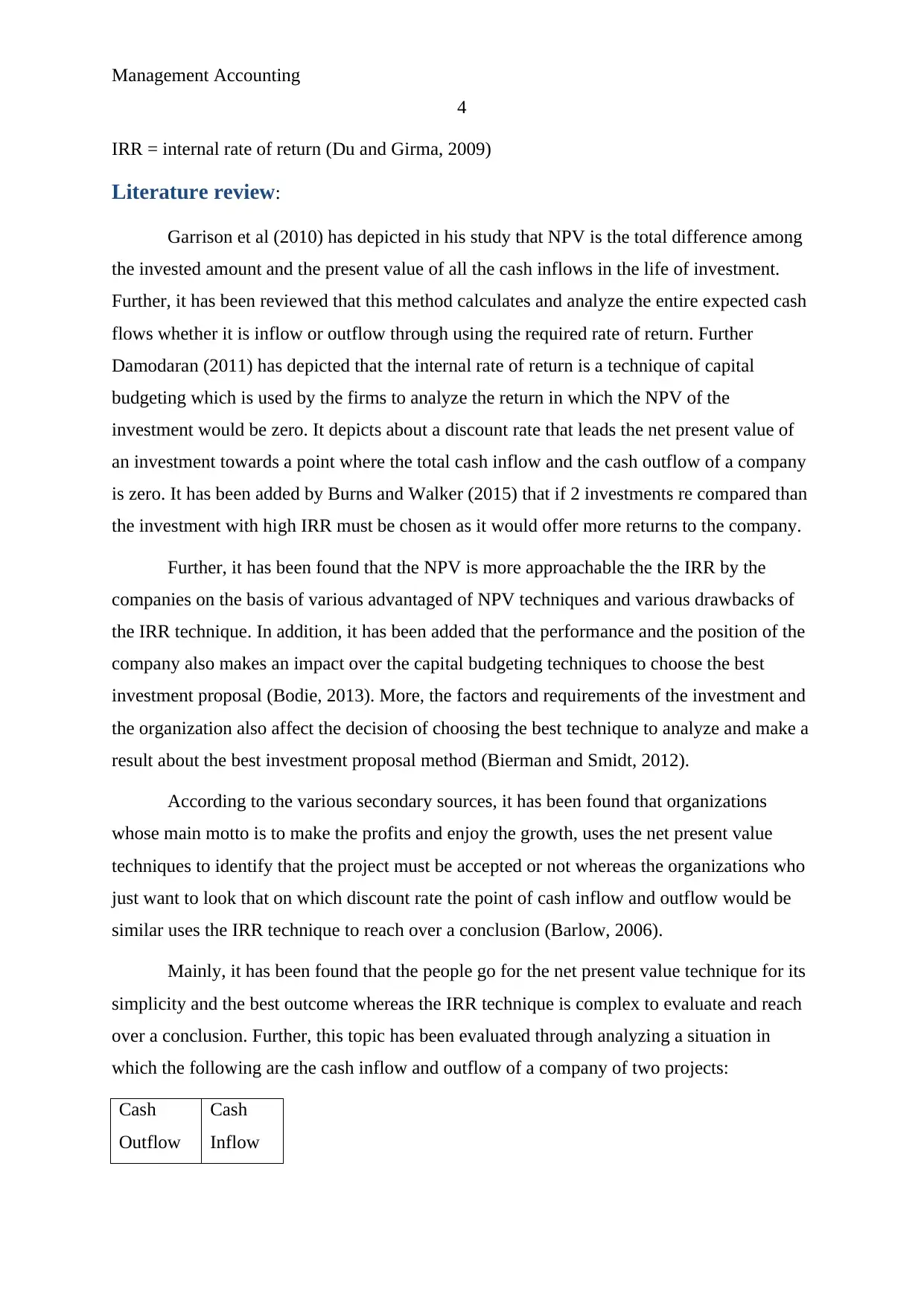
Management Accounting
4
IRR = internal rate of return (Du and Girma, 2009)
Literature review:
Garrison et al (2010) has depicted in his study that NPV is the total difference among
the invested amount and the present value of all the cash inflows in the life of investment.
Further, it has been reviewed that this method calculates and analyze the entire expected cash
flows whether it is inflow or outflow through using the required rate of return. Further
Damodaran (2011) has depicted that the internal rate of return is a technique of capital
budgeting which is used by the firms to analyze the return in which the NPV of the
investment would be zero. It depicts about a discount rate that leads the net present value of
an investment towards a point where the total cash inflow and the cash outflow of a company
is zero. It has been added by Burns and Walker (2015) that if 2 investments re compared than
the investment with high IRR must be chosen as it would offer more returns to the company.
Further, it has been found that the NPV is more approachable the the IRR by the
companies on the basis of various advantaged of NPV techniques and various drawbacks of
the IRR technique. In addition, it has been added that the performance and the position of the
company also makes an impact over the capital budgeting techniques to choose the best
investment proposal (Bodie, 2013). More, the factors and requirements of the investment and
the organization also affect the decision of choosing the best technique to analyze and make a
result about the best investment proposal method (Bierman and Smidt, 2012).
According to the various secondary sources, it has been found that organizations
whose main motto is to make the profits and enjoy the growth, uses the net present value
techniques to identify that the project must be accepted or not whereas the organizations who
just want to look that on which discount rate the point of cash inflow and outflow would be
similar uses the IRR technique to reach over a conclusion (Barlow, 2006).
Mainly, it has been found that the people go for the net present value technique for its
simplicity and the best outcome whereas the IRR technique is complex to evaluate and reach
over a conclusion. Further, this topic has been evaluated through analyzing a situation in
which the following are the cash inflow and outflow of a company of two projects:
Cash
Outflow
Cash
Inflow
4
IRR = internal rate of return (Du and Girma, 2009)
Literature review:
Garrison et al (2010) has depicted in his study that NPV is the total difference among
the invested amount and the present value of all the cash inflows in the life of investment.
Further, it has been reviewed that this method calculates and analyze the entire expected cash
flows whether it is inflow or outflow through using the required rate of return. Further
Damodaran (2011) has depicted that the internal rate of return is a technique of capital
budgeting which is used by the firms to analyze the return in which the NPV of the
investment would be zero. It depicts about a discount rate that leads the net present value of
an investment towards a point where the total cash inflow and the cash outflow of a company
is zero. It has been added by Burns and Walker (2015) that if 2 investments re compared than
the investment with high IRR must be chosen as it would offer more returns to the company.
Further, it has been found that the NPV is more approachable the the IRR by the
companies on the basis of various advantaged of NPV techniques and various drawbacks of
the IRR technique. In addition, it has been added that the performance and the position of the
company also makes an impact over the capital budgeting techniques to choose the best
investment proposal (Bodie, 2013). More, the factors and requirements of the investment and
the organization also affect the decision of choosing the best technique to analyze and make a
result about the best investment proposal method (Bierman and Smidt, 2012).
According to the various secondary sources, it has been found that organizations
whose main motto is to make the profits and enjoy the growth, uses the net present value
techniques to identify that the project must be accepted or not whereas the organizations who
just want to look that on which discount rate the point of cash inflow and outflow would be
similar uses the IRR technique to reach over a conclusion (Barlow, 2006).
Mainly, it has been found that the people go for the net present value technique for its
simplicity and the best outcome whereas the IRR technique is complex to evaluate and reach
over a conclusion. Further, this topic has been evaluated through analyzing a situation in
which the following are the cash inflow and outflow of a company of two projects:
Cash
Outflow
Cash
Inflow
Paraphrase This Document
Need a fresh take? Get an instant paraphrase of this document with our AI Paraphraser
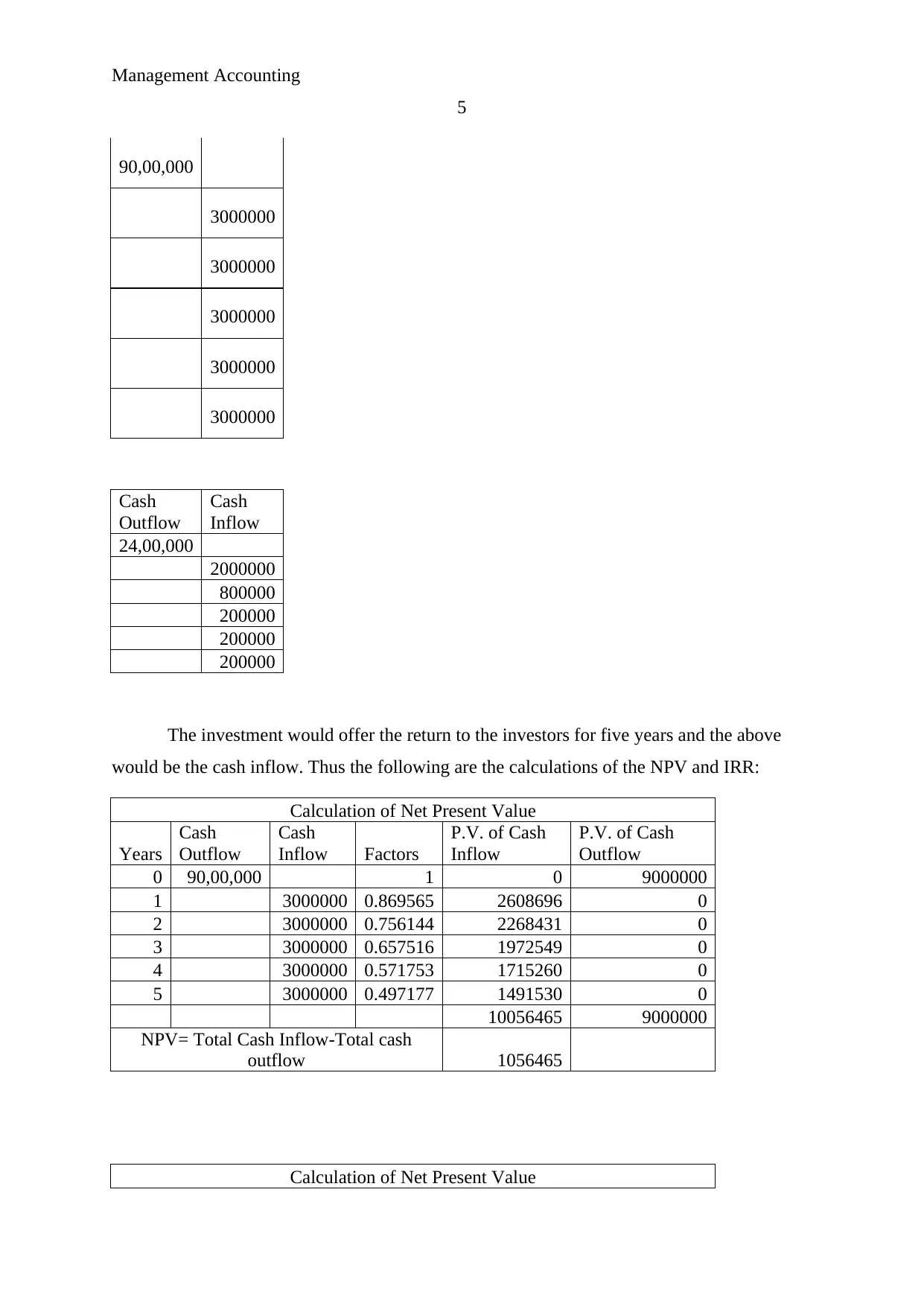
Management Accounting
5
90,00,000
3000000
3000000
3000000
3000000
3000000
Cash
Outflow
Cash
Inflow
24,00,000
2000000
800000
200000
200000
200000
The investment would offer the return to the investors for five years and the above
would be the cash inflow. Thus the following are the calculations of the NPV and IRR:
Calculation of Net Present Value
Years
Cash
Outflow
Cash
Inflow Factors
P.V. of Cash
Inflow
P.V. of Cash
Outflow
0 90,00,000 1 0 9000000
1 3000000 0.869565 2608696 0
2 3000000 0.756144 2268431 0
3 3000000 0.657516 1972549 0
4 3000000 0.571753 1715260 0
5 3000000 0.497177 1491530 0
10056465 9000000
NPV= Total Cash Inflow-Total cash
outflow 1056465
Calculation of Net Present Value
5
90,00,000
3000000
3000000
3000000
3000000
3000000
Cash
Outflow
Cash
Inflow
24,00,000
2000000
800000
200000
200000
200000
The investment would offer the return to the investors for five years and the above
would be the cash inflow. Thus the following are the calculations of the NPV and IRR:
Calculation of Net Present Value
Years
Cash
Outflow
Cash
Inflow Factors
P.V. of Cash
Inflow
P.V. of Cash
Outflow
0 90,00,000 1 0 9000000
1 3000000 0.869565 2608696 0
2 3000000 0.756144 2268431 0
3 3000000 0.657516 1972549 0
4 3000000 0.571753 1715260 0
5 3000000 0.497177 1491530 0
10056465 9000000
NPV= Total Cash Inflow-Total cash
outflow 1056465
Calculation of Net Present Value

Management Accounting
6
Years
Cash
Outflow
Cash
Inflow Factors
P.V. of Cash
Inflow
P.V. of Cash
Outflow
0 24,00,000 1 0 2400000
1 2000000 0.869565 1739130 0
2 800000 0.756144 604914.9 0
3 200000 0.657516 131503.2 0
4 200000 0.571753 114350.6 0
5 200000 0.497177 99435.35 0
2689335 2400000
NPV= Total Cash Inflow-Total cash
outflow
289334.6
Calculation Of IRR
Renovate
Years
Cash
Inflow
0
-
90,00,000
1 3000000
2 3000000
3 3000000
4 3000000
5 3000000
IRR 19.86%
Replacement
Years
Cash
Inflow
0
-
24,00,000
1 2000000
2 800000
3 200000
4 200000
5 200000
23.69%
The above calculations depict that it is bit easy for the analyst and management to
identify and evaluate the net present value whereas the calculations of the IRR is bit difficult
6
Years
Cash
Outflow
Cash
Inflow Factors
P.V. of Cash
Inflow
P.V. of Cash
Outflow
0 24,00,000 1 0 2400000
1 2000000 0.869565 1739130 0
2 800000 0.756144 604914.9 0
3 200000 0.657516 131503.2 0
4 200000 0.571753 114350.6 0
5 200000 0.497177 99435.35 0
2689335 2400000
NPV= Total Cash Inflow-Total cash
outflow
289334.6
Calculation Of IRR
Renovate
Years
Cash
Inflow
0
-
90,00,000
1 3000000
2 3000000
3 3000000
4 3000000
5 3000000
IRR 19.86%
Replacement
Years
Cash
Inflow
0
-
24,00,000
1 2000000
2 800000
3 200000
4 200000
5 200000
23.69%
The above calculations depict that it is bit easy for the analyst and management to
identify and evaluate the net present value whereas the calculations of the IRR is bit difficult
⊘ This is a preview!⊘
Do you want full access?
Subscribe today to unlock all pages.

Trusted by 1+ million students worldwide
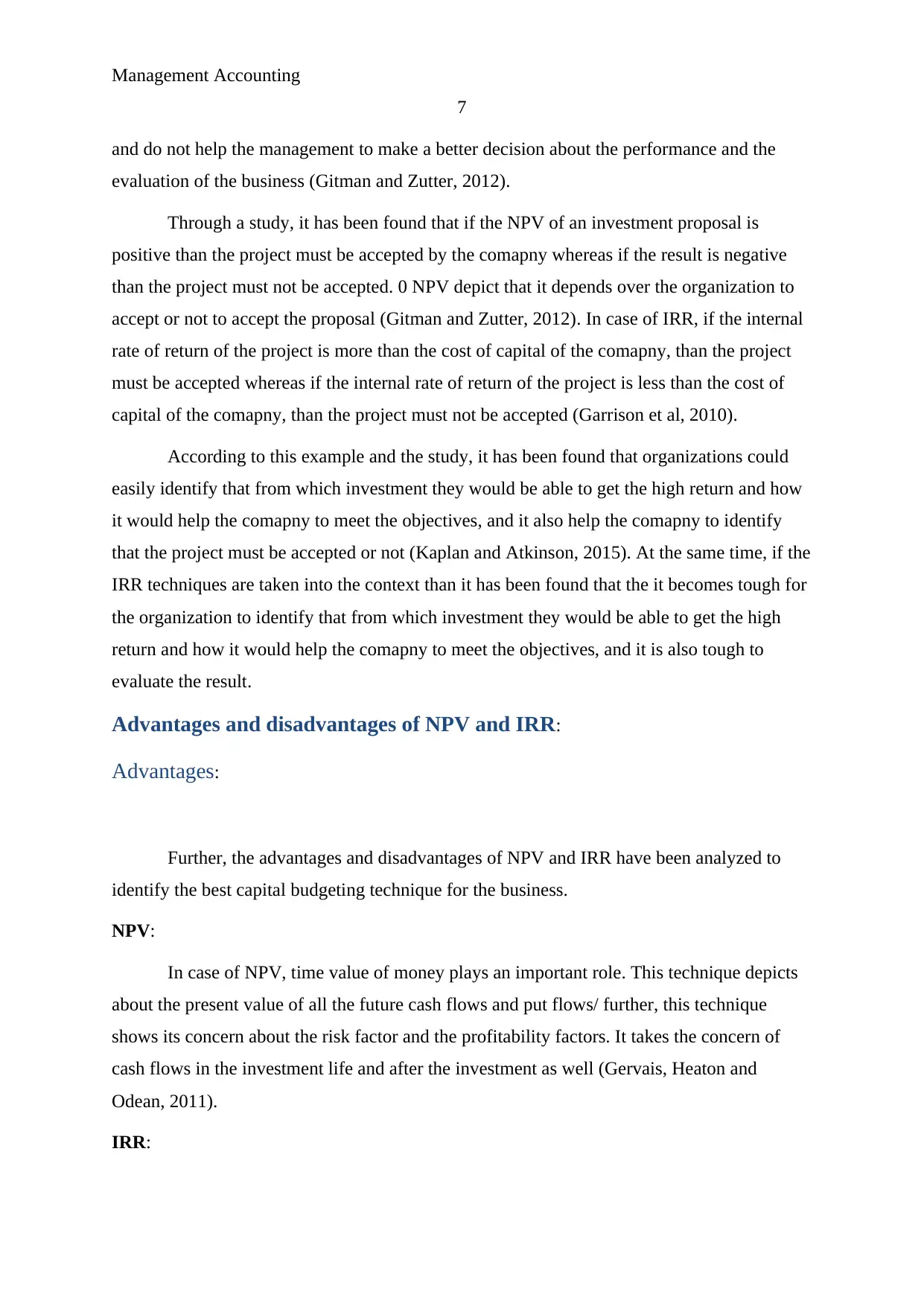
Management Accounting
7
and do not help the management to make a better decision about the performance and the
evaluation of the business (Gitman and Zutter, 2012).
Through a study, it has been found that if the NPV of an investment proposal is
positive than the project must be accepted by the comapny whereas if the result is negative
than the project must not be accepted. 0 NPV depict that it depends over the organization to
accept or not to accept the proposal (Gitman and Zutter, 2012). In case of IRR, if the internal
rate of return of the project is more than the cost of capital of the comapny, than the project
must be accepted whereas if the internal rate of return of the project is less than the cost of
capital of the comapny, than the project must not be accepted (Garrison et al, 2010).
According to this example and the study, it has been found that organizations could
easily identify that from which investment they would be able to get the high return and how
it would help the comapny to meet the objectives, and it also help the comapny to identify
that the project must be accepted or not (Kaplan and Atkinson, 2015). At the same time, if the
IRR techniques are taken into the context than it has been found that the it becomes tough for
the organization to identify that from which investment they would be able to get the high
return and how it would help the comapny to meet the objectives, and it is also tough to
evaluate the result.
Advantages and disadvantages of NPV and IRR:
Advantages:
Further, the advantages and disadvantages of NPV and IRR have been analyzed to
identify the best capital budgeting technique for the business.
NPV:
In case of NPV, time value of money plays an important role. This technique depicts
about the present value of all the future cash flows and put flows/ further, this technique
shows its concern about the risk factor and the profitability factors. It takes the concern of
cash flows in the investment life and after the investment as well (Gervais, Heaton and
Odean, 2011).
IRR:
7
and do not help the management to make a better decision about the performance and the
evaluation of the business (Gitman and Zutter, 2012).
Through a study, it has been found that if the NPV of an investment proposal is
positive than the project must be accepted by the comapny whereas if the result is negative
than the project must not be accepted. 0 NPV depict that it depends over the organization to
accept or not to accept the proposal (Gitman and Zutter, 2012). In case of IRR, if the internal
rate of return of the project is more than the cost of capital of the comapny, than the project
must be accepted whereas if the internal rate of return of the project is less than the cost of
capital of the comapny, than the project must not be accepted (Garrison et al, 2010).
According to this example and the study, it has been found that organizations could
easily identify that from which investment they would be able to get the high return and how
it would help the comapny to meet the objectives, and it also help the comapny to identify
that the project must be accepted or not (Kaplan and Atkinson, 2015). At the same time, if the
IRR techniques are taken into the context than it has been found that the it becomes tough for
the organization to identify that from which investment they would be able to get the high
return and how it would help the comapny to meet the objectives, and it is also tough to
evaluate the result.
Advantages and disadvantages of NPV and IRR:
Advantages:
Further, the advantages and disadvantages of NPV and IRR have been analyzed to
identify the best capital budgeting technique for the business.
NPV:
In case of NPV, time value of money plays an important role. This technique depicts
about the present value of all the future cash flows and put flows/ further, this technique
shows its concern about the risk factor and the profitability factors. It takes the concern of
cash flows in the investment life and after the investment as well (Gervais, Heaton and
Odean, 2011).
IRR:
Paraphrase This Document
Need a fresh take? Get an instant paraphrase of this document with our AI Paraphraser
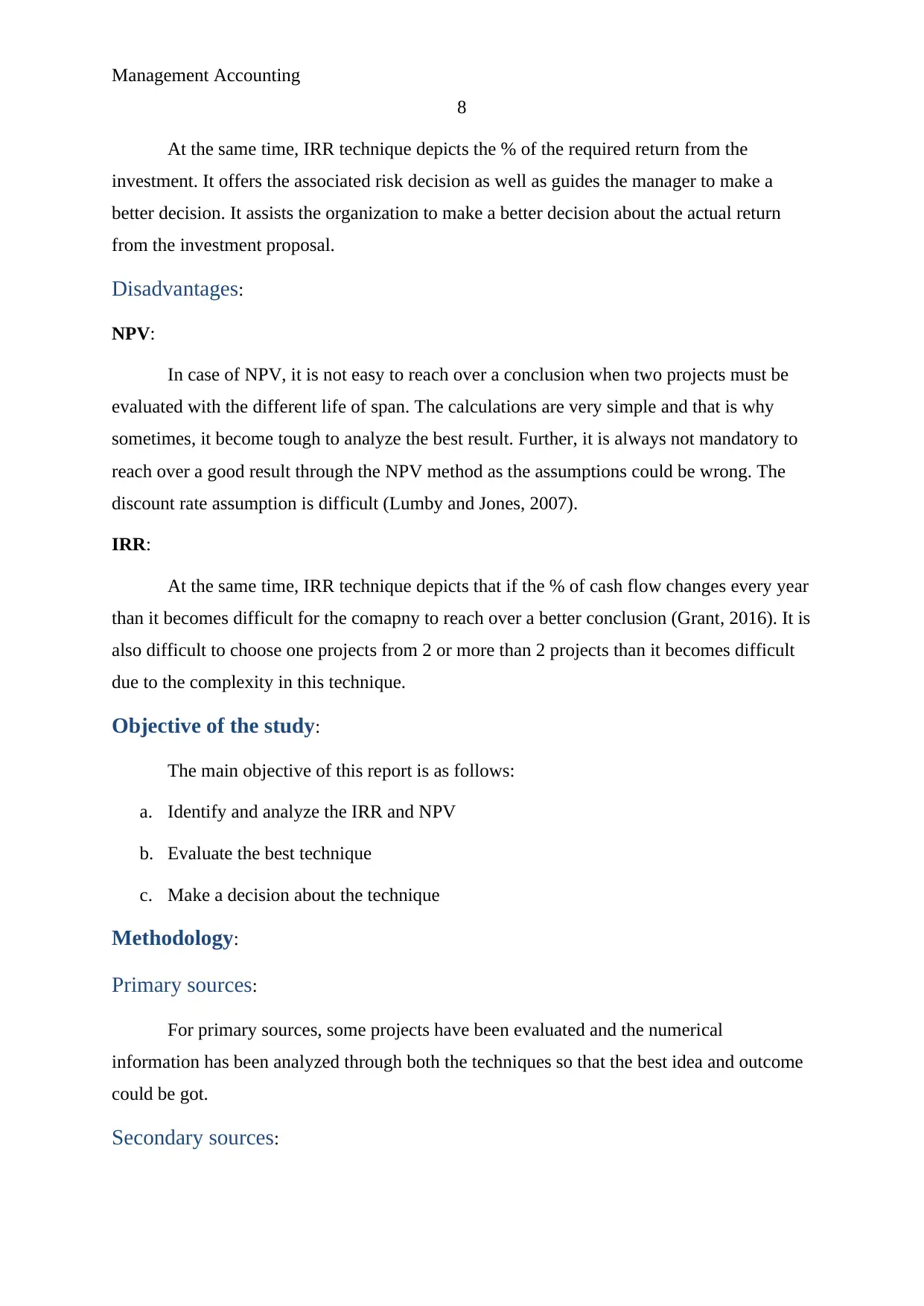
Management Accounting
8
At the same time, IRR technique depicts the % of the required return from the
investment. It offers the associated risk decision as well as guides the manager to make a
better decision. It assists the organization to make a better decision about the actual return
from the investment proposal.
Disadvantages:
NPV:
In case of NPV, it is not easy to reach over a conclusion when two projects must be
evaluated with the different life of span. The calculations are very simple and that is why
sometimes, it become tough to analyze the best result. Further, it is always not mandatory to
reach over a good result through the NPV method as the assumptions could be wrong. The
discount rate assumption is difficult (Lumby and Jones, 2007).
IRR:
At the same time, IRR technique depicts that if the % of cash flow changes every year
than it becomes difficult for the comapny to reach over a better conclusion (Grant, 2016). It is
also difficult to choose one projects from 2 or more than 2 projects than it becomes difficult
due to the complexity in this technique.
Objective of the study:
The main objective of this report is as follows:
a. Identify and analyze the IRR and NPV
b. Evaluate the best technique
c. Make a decision about the technique
Methodology:
Primary sources:
For primary sources, some projects have been evaluated and the numerical
information has been analyzed through both the techniques so that the best idea and outcome
could be got.
Secondary sources:
8
At the same time, IRR technique depicts the % of the required return from the
investment. It offers the associated risk decision as well as guides the manager to make a
better decision. It assists the organization to make a better decision about the actual return
from the investment proposal.
Disadvantages:
NPV:
In case of NPV, it is not easy to reach over a conclusion when two projects must be
evaluated with the different life of span. The calculations are very simple and that is why
sometimes, it become tough to analyze the best result. Further, it is always not mandatory to
reach over a good result through the NPV method as the assumptions could be wrong. The
discount rate assumption is difficult (Lumby and Jones, 2007).
IRR:
At the same time, IRR technique depicts that if the % of cash flow changes every year
than it becomes difficult for the comapny to reach over a better conclusion (Grant, 2016). It is
also difficult to choose one projects from 2 or more than 2 projects than it becomes difficult
due to the complexity in this technique.
Objective of the study:
The main objective of this report is as follows:
a. Identify and analyze the IRR and NPV
b. Evaluate the best technique
c. Make a decision about the technique
Methodology:
Primary sources:
For primary sources, some projects have been evaluated and the numerical
information has been analyzed through both the techniques so that the best idea and outcome
could be got.
Secondary sources:
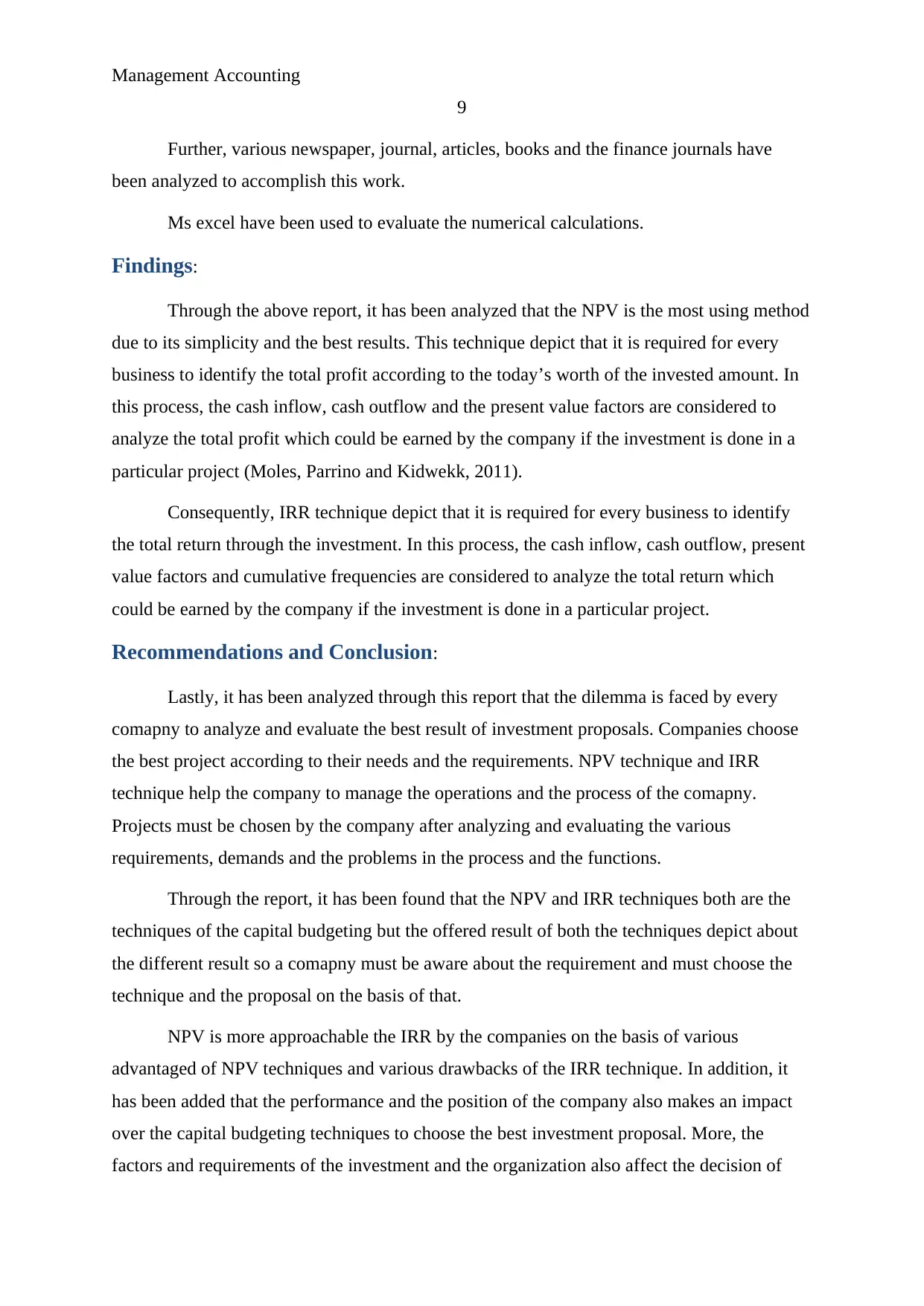
Management Accounting
9
Further, various newspaper, journal, articles, books and the finance journals have
been analyzed to accomplish this work.
Ms excel have been used to evaluate the numerical calculations.
Findings:
Through the above report, it has been analyzed that the NPV is the most using method
due to its simplicity and the best results. This technique depict that it is required for every
business to identify the total profit according to the today’s worth of the invested amount. In
this process, the cash inflow, cash outflow and the present value factors are considered to
analyze the total profit which could be earned by the company if the investment is done in a
particular project (Moles, Parrino and Kidwekk, 2011).
Consequently, IRR technique depict that it is required for every business to identify
the total return through the investment. In this process, the cash inflow, cash outflow, present
value factors and cumulative frequencies are considered to analyze the total return which
could be earned by the company if the investment is done in a particular project.
Recommendations and Conclusion:
Lastly, it has been analyzed through this report that the dilemma is faced by every
comapny to analyze and evaluate the best result of investment proposals. Companies choose
the best project according to their needs and the requirements. NPV technique and IRR
technique help the company to manage the operations and the process of the comapny.
Projects must be chosen by the company after analyzing and evaluating the various
requirements, demands and the problems in the process and the functions.
Through the report, it has been found that the NPV and IRR techniques both are the
techniques of the capital budgeting but the offered result of both the techniques depict about
the different result so a comapny must be aware about the requirement and must choose the
technique and the proposal on the basis of that.
NPV is more approachable the IRR by the companies on the basis of various
advantaged of NPV techniques and various drawbacks of the IRR technique. In addition, it
has been added that the performance and the position of the company also makes an impact
over the capital budgeting techniques to choose the best investment proposal. More, the
factors and requirements of the investment and the organization also affect the decision of
9
Further, various newspaper, journal, articles, books and the finance journals have
been analyzed to accomplish this work.
Ms excel have been used to evaluate the numerical calculations.
Findings:
Through the above report, it has been analyzed that the NPV is the most using method
due to its simplicity and the best results. This technique depict that it is required for every
business to identify the total profit according to the today’s worth of the invested amount. In
this process, the cash inflow, cash outflow and the present value factors are considered to
analyze the total profit which could be earned by the company if the investment is done in a
particular project (Moles, Parrino and Kidwekk, 2011).
Consequently, IRR technique depict that it is required for every business to identify
the total return through the investment. In this process, the cash inflow, cash outflow, present
value factors and cumulative frequencies are considered to analyze the total return which
could be earned by the company if the investment is done in a particular project.
Recommendations and Conclusion:
Lastly, it has been analyzed through this report that the dilemma is faced by every
comapny to analyze and evaluate the best result of investment proposals. Companies choose
the best project according to their needs and the requirements. NPV technique and IRR
technique help the company to manage the operations and the process of the comapny.
Projects must be chosen by the company after analyzing and evaluating the various
requirements, demands and the problems in the process and the functions.
Through the report, it has been found that the NPV and IRR techniques both are the
techniques of the capital budgeting but the offered result of both the techniques depict about
the different result so a comapny must be aware about the requirement and must choose the
technique and the proposal on the basis of that.
NPV is more approachable the IRR by the companies on the basis of various
advantaged of NPV techniques and various drawbacks of the IRR technique. In addition, it
has been added that the performance and the position of the company also makes an impact
over the capital budgeting techniques to choose the best investment proposal. More, the
factors and requirements of the investment and the organization also affect the decision of
⊘ This is a preview!⊘
Do you want full access?
Subscribe today to unlock all pages.

Trusted by 1+ million students worldwide

Management Accounting
10
choosing the best technique to analyze and make a result about the best investment proposal
method.
To conclude, all the organizations which are performing and running their business in
the international market are using the NPV technique due to its simplicity and the best
evaluation methods.
10
choosing the best technique to analyze and make a result about the best investment proposal
method.
To conclude, all the organizations which are performing and running their business in
the international market are using the NPV technique due to its simplicity and the best
evaluation methods.
Paraphrase This Document
Need a fresh take? Get an instant paraphrase of this document with our AI Paraphraser
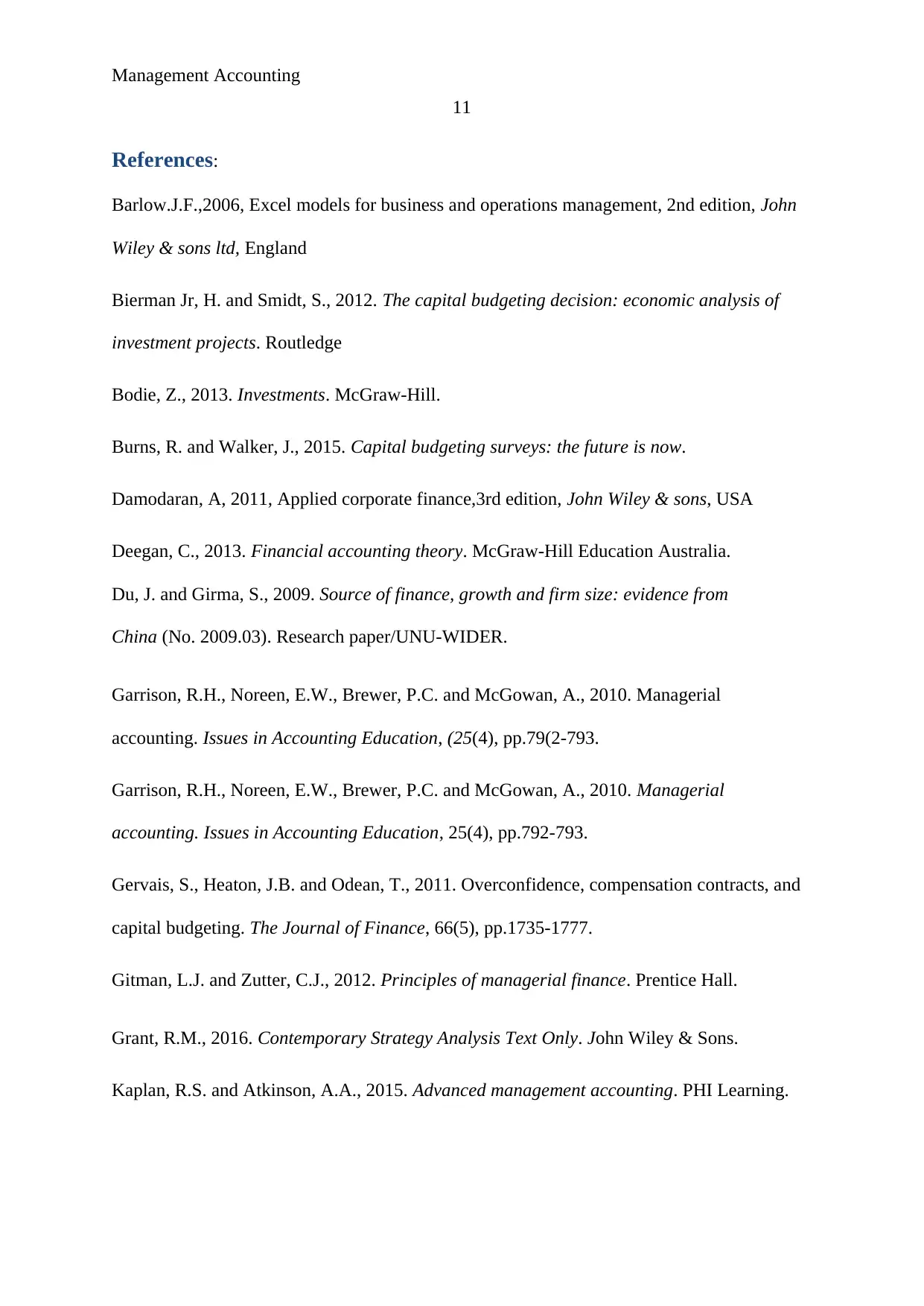
Management Accounting
11
References:
Barlow.J.F.,2006, Excel models for business and operations management, 2nd edition, John
Wiley & sons ltd, England
Bierman Jr, H. and Smidt, S., 2012. The capital budgeting decision: economic analysis of
investment projects. Routledge
Bodie, Z., 2013. Investments. McGraw-Hill.
Burns, R. and Walker, J., 2015. Capital budgeting surveys: the future is now.
Damodaran, A, 2011, Applied corporate finance,3rd edition, John Wiley & sons, USA
Deegan, C., 2013. Financial accounting theory. McGraw-Hill Education Australia.
Du, J. and Girma, S., 2009. Source of finance, growth and firm size: evidence from
China (No. 2009.03). Research paper/UNU-WIDER.
Garrison, R.H., Noreen, E.W., Brewer, P.C. and McGowan, A., 2010. Managerial
accounting. Issues in Accounting Education, (25(4), pp.79(2-793.
Garrison, R.H., Noreen, E.W., Brewer, P.C. and McGowan, A., 2010. Managerial
accounting. Issues in Accounting Education, 25(4), pp.792-793.
Gervais, S., Heaton, J.B. and Odean, T., 2011. Overconfidence, compensation contracts, and
capital budgeting. The Journal of Finance, 66(5), pp.1735-1777.
Gitman, L.J. and Zutter, C.J., 2012. Principles of managerial finance. Prentice Hall.
Grant, R.M., 2016. Contemporary Strategy Analysis Text Only. John Wiley & Sons.
Kaplan, R.S. and Atkinson, A.A., 2015. Advanced management accounting. PHI Learning.
11
References:
Barlow.J.F.,2006, Excel models for business and operations management, 2nd edition, John
Wiley & sons ltd, England
Bierman Jr, H. and Smidt, S., 2012. The capital budgeting decision: economic analysis of
investment projects. Routledge
Bodie, Z., 2013. Investments. McGraw-Hill.
Burns, R. and Walker, J., 2015. Capital budgeting surveys: the future is now.
Damodaran, A, 2011, Applied corporate finance,3rd edition, John Wiley & sons, USA
Deegan, C., 2013. Financial accounting theory. McGraw-Hill Education Australia.
Du, J. and Girma, S., 2009. Source of finance, growth and firm size: evidence from
China (No. 2009.03). Research paper/UNU-WIDER.
Garrison, R.H., Noreen, E.W., Brewer, P.C. and McGowan, A., 2010. Managerial
accounting. Issues in Accounting Education, (25(4), pp.79(2-793.
Garrison, R.H., Noreen, E.W., Brewer, P.C. and McGowan, A., 2010. Managerial
accounting. Issues in Accounting Education, 25(4), pp.792-793.
Gervais, S., Heaton, J.B. and Odean, T., 2011. Overconfidence, compensation contracts, and
capital budgeting. The Journal of Finance, 66(5), pp.1735-1777.
Gitman, L.J. and Zutter, C.J., 2012. Principles of managerial finance. Prentice Hall.
Grant, R.M., 2016. Contemporary Strategy Analysis Text Only. John Wiley & Sons.
Kaplan, R.S. and Atkinson, A.A., 2015. Advanced management accounting. PHI Learning.
1 out of 11
Related Documents
Your All-in-One AI-Powered Toolkit for Academic Success.
+13062052269
info@desklib.com
Available 24*7 on WhatsApp / Email
![[object Object]](/_next/static/media/star-bottom.7253800d.svg)
Unlock your academic potential
Copyright © 2020–2025 A2Z Services. All Rights Reserved. Developed and managed by ZUCOL.



